Content
Published:
Updated:
This is an archived release.
Fewer thefts gave higher clear-up rate
The police and the Prosecution authority completed the investigation of more than 349 000 offences in 2014. Of these, more than 174 000 were considered solved. The number of reported and investigated thefts was 10 per cent fewer than in 2013, and this drop has contributed to the changes in the clear-up rate.
| 2014 | |
|---|---|
| Offences investigated | 349 325 |
| Offences investigated and solved | 174 384 |
| Charges against persons | 176 208 |
| Persons charged | 81 198 |
| Persons charged in base year included in recidivism statistics | 75 463 |
| Persons charged in base year with recidivism in the following five-year period | 34 006 |
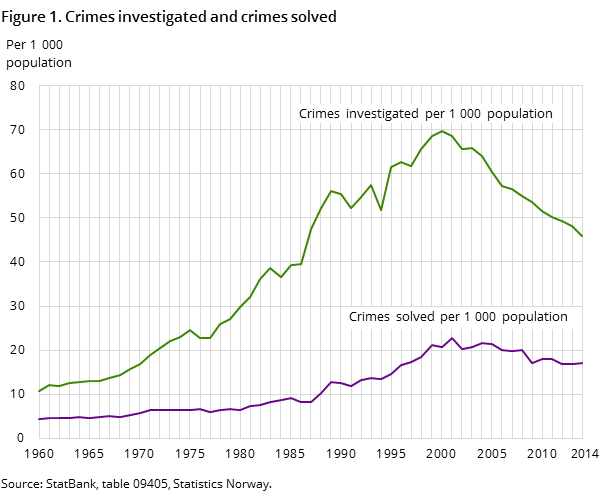
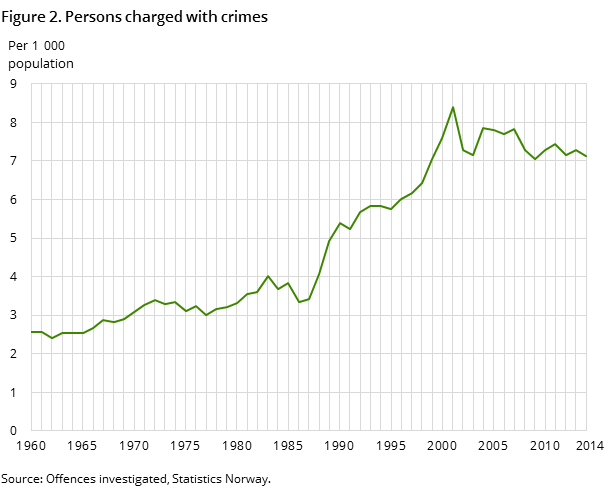
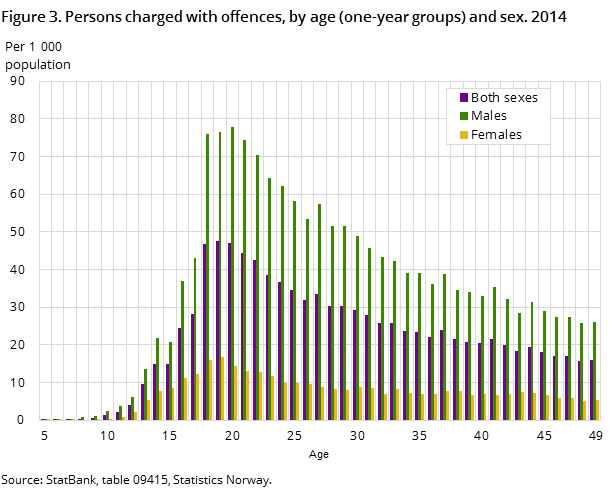
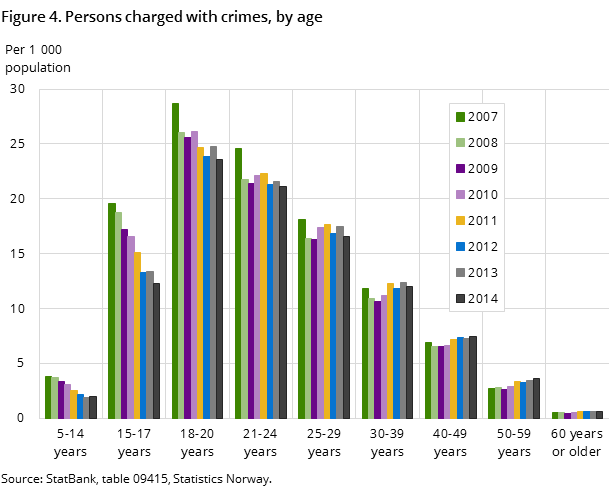
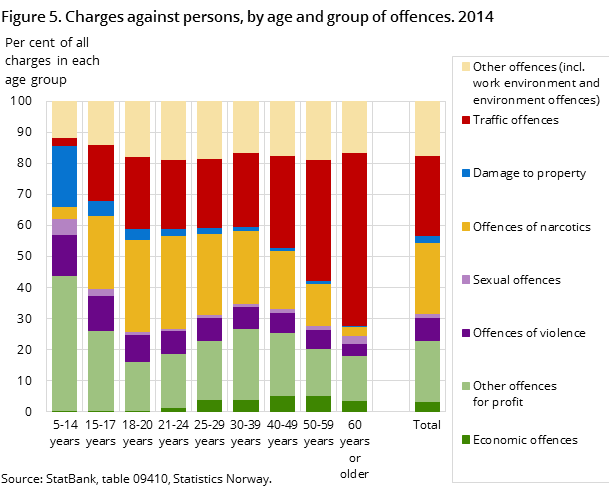
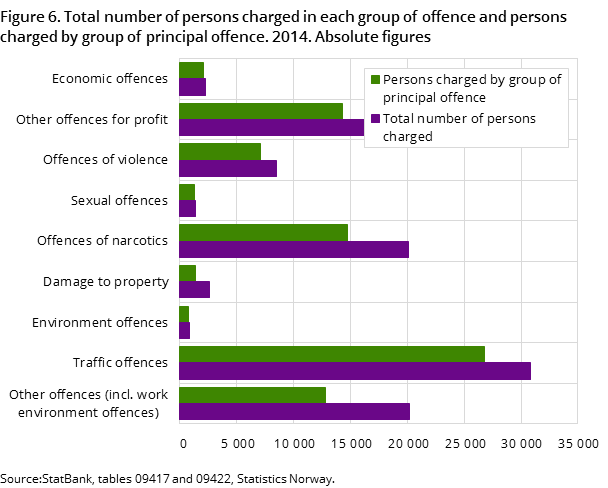
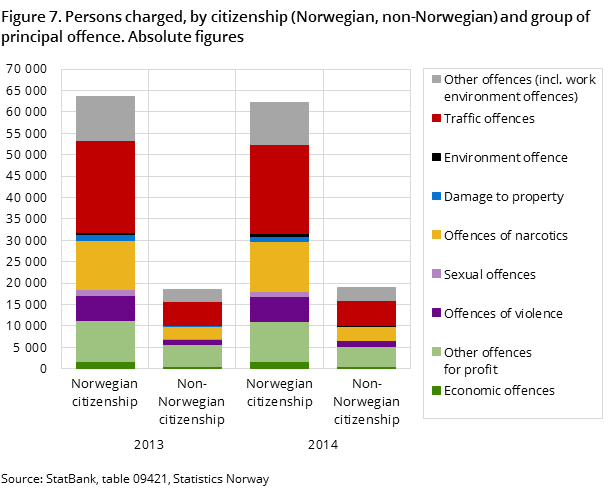
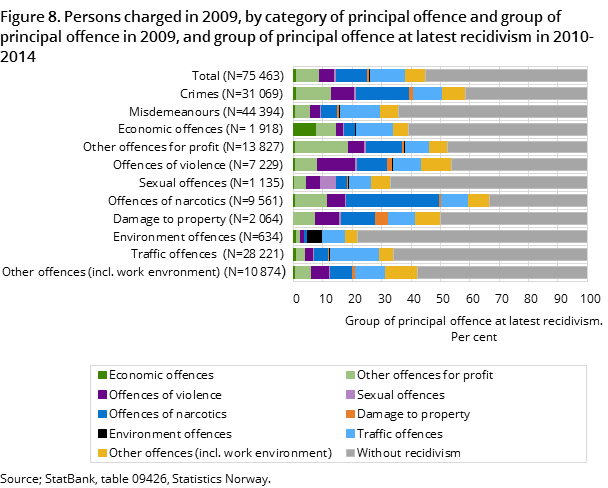
The police and the Prosecution authority completed the investigation of 236 700 crimes and 112 600 misdemeanours in 2014. This is 9 500 fewer crimes, but 1 700 more misdemeanours than the year before. When we account for the population growth, the total number of investigated crimes was nearly 5 per cent less than in 2013, and as much as 34 per cent less than in 2000 – as shown in figure 1.
Last year’s decline was by far greatest for other offences for profit, which were down 12 500 in 2014 from the year before. The scope of investigated damage to property also saw a slight decline, while the number of violent offences was equal to 2013. On the other hand, more offences of narcotics were investigated, as well as more economic offences and other offences. In 2014, a total of 57 500 traffic misdemeanours were a legally binding decision, which is nearly 2 000 more than in 2013.
Half of all offences unsolved
Of all investigated offences completed in 2014, 174 400 were considered solved and 174 900 were considered unsolved.
Whether an offence is considered solved or not, and which type of penal decision is given, varies greatly among the different groups and types of offences. Of the crime groups, offences of narcotics have the highest clear-up rate, with 83 per cent in 2014. Other offences for profit and damage to property are the groups of offences with the lowest clear-up rate, with 22 and 20 per cent respectively.
Reported thefts affects the total clear-up rate
The difference in the composition of reported and investigated types of offences is vital to understanding the changes in clear-up rates from year to year.
That the total clear-up rate increased from 35 per cent in 2013 to 37 per cent in 2014 is mainly connected to the decline in the number of reported thefts – which is a type of offence with a relatively low clear-up rate. However, the increase in reported and investigated narcotic and traffic offences – offences with high clear-up rates – also contributed to the overall increase in the clear-up rate for both crimes and offences in total.
Solved thefts equal to the year before
Of the almost 111 000 thefts with legally binding decisions in 2014, less than 13 600 ended with a person committed for trial, a ticket fine or another decision considered to be solved. For most of the specified types of thefts, solved offences are roughly level with the year before, and thus contribute to the total number of solved thefts being equal to the historical low level from the previous two years.
A big drop in reported and unsolved thefts
In 2014, 97 400 thefts were considered unsolved1, of which 94 per cent had prosecution dropped due to insufficient information about the offender.
Compared to the year before, there were 12 600 fewer unsolved thefts, including 4 800 fewer unsolved incidents of minor larcenies and 7 600 fewer unsolved aggravated larcenies. Among the aggravated larcenies, there was an especially big drop in the number of reported and unsolved incidents of aggravated larceny from a person in a public place – with as much as 5 300 fewer than the year before.
The drop in these kinds of thefts is also highlighted in the statistics on Offences reported to the police 2014. In other words, it is the drop in the number of reported offences, and not the number of solved thefts, that explains for the most part the increase in the clear-up rate for most types of theft from the year before. The drop in reported thefts also contributes to the clear-up rate for thefts rising from under 11 per cent in 2013 to over 12 per cent in 2014.
Fewer persons charged with other offences for profit
A total of 18 400 persons were charged with nearly 34 800 charges for theft and other offences for profit in 2014. Of these, nearly 15 per cent were also charged with other offences with a higher maximum sentence, as shown in figure 6. Thus, 14 300 persons were charged with other offences for profit as their principal offence, which is nearly 2 per cent fewer than in 2013 and 12 per cent fewer than in 2009.
The spread of persons charged among the more specified types of offences for profit varies, but in 2014 there were fewer persons charged for most types of theft than the year before. For example, there was a decline in the number of persons charged with motor vehicle-related thefts, which enhances the downward trend from the previous decade.
Many charged only for traffic misdemeanours
In 2014, investigations by the police and the Prosecution authority resulted in a total of 176 200 charges against 81 200 different persons.
Just over 45 800 charges were given for traffic misdemeanours, and these were given to a total of 30 800 different persons. Among the traffic violators, 26 800 also had the traffic offence as their principal offence, while the remaining 4 000 persons were also charged with other types of offences with a higher maximum sentence from the Penal code – as shown in figure 6. Persons charged with traffic misdemeanours as their principal offence thus make up 60 per cent of all persons that are only charged with a misdemeanour.
Record high number of persons charged with narcotic offences
A total of nearly 20 100 persons were charged with as many as 40 300 charges for narcotic offences in 2014. Thus, over half of the total 36 800 persons charged with a crime were charged with at least one narcotic offence. In the age group 18-20 years, narcotic offences made up more than two thirds of the charged persons.
Of all persons charged with narcotic offences, 14 700 had the narcotic offence as their principal offence. This is just over 1 per cent more than the historically high figure in 2013. The increase from last year only comprises men, and nearly 85 per cent of all persons charged with narcotic offences as their principal offence are men. In terms of percentages, persons without Norwegian citizenship have had a bigger increase than those with a Norwegian citizenship. Thus, non-Norwegians made up 21 per cent of all persons charged with narcotic offences in 2014.
8 500 persons charged with violence
In 2014, the police and Prosecution authority completed the investigation of nearly 25 300 offences of violence. Among these, 13 400 were considered solved. The investigations led to a total of 8 500 different persons being charged with 13 000 charges for violent offences. Among the charges for violence, 6 150 were for assault, 2 800 for threats and 1 500 for wounding or inflicting bodily harm.
Continued increase in ill-treatment within family relations
In 2014, the investigation of 2 350 cases of ill-treatment within family relations was completed, of which 650 cases were considered solved. In 99 per cent of the remaining 1 700 cases, prosecution was dropped due to deficient evidence. However, the number of completed investigations, charges and charged persons is higher in 2014 than in any of the previous years – succeeding the 2006 legislation on ill-treatment within family relations.
Fewer young people charged with violence
In 2014, a total of 7 100 persons had one violent offence as their principal offence. This is somewhat less than the year before and 9 per cent less than in 2007. The decrease from last year in the number of persons charged with violence only concerns young people under the age of 25. Furthermore, there was a decrease of 10 per cent for those under 21 years, and the number of charged persons in the age groups 5-14 years and 15-17 years has more than halved since 2007. The corresponding drop for the age group 18-20 years is 26 per cent.
Persons in the younger age groups seem to have been less often involved in incidences of violence during these years. This is a trend that is also supported by the statistics on Victims of offences reported to the police and the mapping of victimisation of violence in the survey of living conditions. The drop in young people being charged with violence has also contributed to the more widespread trend of a further decreased level of charged young adults and children – as shown in figure 4.
18-21 year-olds still have the highest share of persons charged
Despite the decrease in the last couple of years, young people in the age group 18-21 years are still overrepresented among persons charged with offences – for both sexes and among both crimes and misdemeanours. Among the resident population in this age group, about 4.4 per cent were charged in 2014.
As illustrated in figure 3, men are charged with offences more often than women, thus of all persons charged in 2014, nearly 84 per cent were men. In 2014, 7.3 per cent of all men in the population aged 18-20 years were charged with one or more offence, and 3.6 per cent were charged with one or more crime. Among the female population, the corresponding shares were 1.5 and 0.7 per cent.
More non-Norwegians charged with traffic misdemeanours
In 2014, 18 900 of the charged persons had a non-Norwegian citizenship. This is 2 per cent more than the year before, but the increase is significantly smaller than the increase in the non-Norwegian population in the last couple of years.
Compared to the year before, 2014 saw a 6 per cent increase in non-Norwegians charged with one traffic misdemeanour, and a 5 per cent decrease among non-Norwegians charged with one offence for profit. These numbers, derived from the principal offence, are shown in figure 7. Of all persons charged in 2014, both for crimes and among those only charged with a misdemeanour, 23 per cent had a non-Norwegian citizenship.
In addition to the Norwegian and non-Norwegian citizens registered as residing in Norway, there are also persons charged with offences while living shorter or longer periods of time abroad. For those registered as residing abroad, the number of persons charged with crime was equal to the year before, while there was an almost 7 per cent increase for those charged with misdemeanours. Thus, charged persons residing abroad made up 10 per cent of all persons charged with crime in 2014. The corresponding share for those charged with traffic offences and other misdemeanours as their principal offence was under 8 per cent.
Lower share with recidivism
The statistics on recidivism among the population in Norway show that 45 per cent of the 75 500 charged persons in 2009 were charged for at least one new offence during the next five years. This share has gradually dropped during the last seven statistics on recidivism, and the corresponding share in 2002 was nearly 50 per cent.
Spread by group of principal offence, the by far highest rate of recidivism is registered among those originally charged with narcotic offences. As shown in figure 8, 67 per cent of those charged with narcotic offences in 2009 were charged with at least one new offence during the succeeding five-year period. The corresponding share among those originally charged with violence or offences for profit is 54 and 52 per cent respectively. Of all persons charged with a sexual offence as their principal offence in 2009, one out of three has registered recidivism during the years 2010-2014.
Recidivism rate still highest among men
The last statistics on recidivism show that the recidivism rate among men is 48 per cent, while the corresponding female recidivism rate is 30 per cent. However, the share of men with recidivism is still decreasing with higher age, while there are far less disparities among the different female age groups.
As in earlier years, the stand-out age group for recidivist males is 15-17 years, and 63 per cent of the 4 600 young men charged in 2009 were registered with recidivism during the years 2010-2014. This share is smaller than in previous years, and we have to go as far back as 1997 to find a correspondingly small share of recidivism in this age group.
1 09.11.2015: "thefts considered solved" replaced with "thefts considered unsolved".
Relocate and change of the Penal code on return to the country after expulsionOpen and readClose
The Immigration Act of Return for Expulsion (§ 108, paragraph 3) entered into force on 15 January 2014 and replaced the corresponding provision in the Penal Code (§ 342, paragraph 1). This entails a redistribution of statistics that use Statistics Norway’s standards Category of offences and Type of offence (but not Group of offence). Returning after expulsion was previously categorised as Misdemeanour in the offence type Other, an offence against the Criminal Code. After these changes, it is categorised as Crimes. In the statistics on offences investigated, this redistribution led to 201 more crimes, 136 more charges and 103 more persons charged in the category Crime against other Acts.
Contact
-
Reid Jone Stene
E-mail: reid.jone.stene@ssb.no
tel.: (+47) 99 02 22 01
-
Siri Fjærtoft Fossanger
E-mail: siri.fossanger@ssb.no
tel.: (+47) 99 72 49 27
-
Sigmund Book Mohn
E-mail: sigmund.mohn@ssb.no
tel.: (+47) 94 32 77 22
